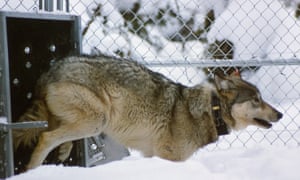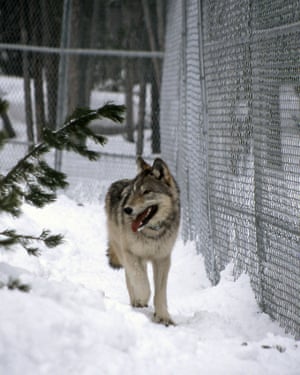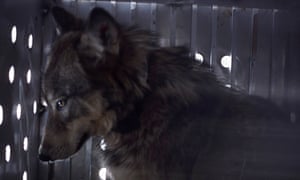https://www.theguardian.com/environment/2020/jan/25/yellowstone-wolf-project-25th-anniversary?fbclid=IwAR0OaYOR0PkwbWJJ02LJkq6kSsOq1cdFl_Dy2RRzmbaXZNMrqsfVm9q3Qb8
A rewilding triumph: wolves help to reverse Yellowstone degradation
Twenty-five years ago, the national park attempted to reintroduce wolves – now scientists are celebrating it as one of the greatest rewilding stories ever
Twenty-five years ago this month, wolves were reintroduced to Yellowstone, America’s first national park and an ecosystem dangerously out of whack owing to the extirpation of its top predator.
This monumental undertaking marked the first deliberate attempt to return a top-level carnivore to a large ecosystem. Now scientists are celebrating the gray wolves’ successful return from the brink of extinction as one of the greatest rewilding stories the world has ever seen.
“The pressure was huge with this project,” said Doug Smith, the senior wildlife biologist of the Yellowstone Wolf Project who was hired by the National Park Service (NPS) to head the reintroduction in the 1990s. “If we couldn’t do this here, on our own turf in one of the most famous parks in the world, as one of the richest nations in the world, then who could? This was an example to the globe in restoring nature.”
But because wolves are one of the most controversial animals on the planet, the recovery remains fiercely contested.
Wolves once roamed from the Arctic to Mexico, but they were hunted to eradication across the country from the 1870s onward. By 1926, the last wolf pack had been killed in Yellowstone by park employees as part of the policy of the time to eliminate all predators.
They were mythologized as a danger to humans, a menace to the ranchers settling the west and competition for big-game hunters. That mythology still persists to this day, although wolves very rarely attack people, especially compared with cougars and bears. Wolves kill 0.2% to 0.3% of available livestock.
When the Endangered Species Act (ESA) was enacted in the 70s, wolves were among the original species on the list. The ESA, a landmark piece of legislation to save declining species from extinction, compels the US Fish and Wildlife Service to protect endangered or threatened species and develop a plan for their recovery. But because wolves are so polarizing, the reintroduction did not take place until more than 20 years later.
The need for restoration was glaring. In the 70 years of the wolves’ absence, the entire Yellowstone ecosystem had fallen out of balance. Coyotes ran rampant, and the elk population exploded, overgrazing willows and aspens. Without those trees, songbirds began to decline, beavers could no longer build their dams and riverbanks started to erode. Without beaver dams and the shade from trees and other plants, water temperatures were too high for cold-water fish.
In 1995, in collaboration with Canadian agencies, 14 wolves were captured in Jasper national park and brought to Yellowstone. Smith recalls that as they transported the wolves through the park in horse trailers, people lined the roads to be part of the historic event. “Every time we stopped, visitors would come up and ask if they could pose next to the trailer. You couldn’t even see the wolves in there, but people wanted photos. That’s the presence and magic that wolves have, and that’s the first time we all felt that.”
In Yellowstone, the wolves were kept in acclimation pens for several weeks to keep their homing instincts from leading them back to Canada. Shortly after the pens were opened, though, wolf No 10 headed north and crossed the border into Montana, followed by No 9, his mate, pregnant with pups. He was illegally shot by a rancher, but she and her eight pups were rescued and moved back to the safety of park boundaries. Their bloodline can be traced to most of the wolves in the park to this day.
Scientists always knew that as the top predator, wolves were the missing piece in this ecosystem. But they were astonished at how quickly their return stimulated a transformation. The elk and deer populations started responding immediately. Within about 10 years, willows rebounded. In 20, the aspen began flourishing. Riverbanks stabilized. Songbirds returned as did beavers, eagles, foxes and badgers. “And those are just the things we have the time and funding to study,” said Smith. “There are probably myriad other effects just waiting to be discovered.”
While the restoration of wolves in Yellowstone has cost about $30m, wolf ecotourism brings in $35m annually, in an economic boom for the surrounding communities. Yellowstone is unique in the world as the best place to observe wild wolves, which are generally shy, reclusive and favor remote areas. This is as true for scientists as it is tourists, and as a result, wolf research in the park is considered far more advanced than anywhere else.
Wolves have repopulated parts of their historic range as far south as Colorado, where evidence of a pack was just discovered earlier this month, as far west as Mount Lassen in northern California, and to the doorsteps of the Cascades in eastern Oregon and Washington.
“It truly is going to go down in my career as one of those defining moments I was proud of to be part of from the beginning, that’s shaping the politics of conservation,” said Jamie Rappaport Clark, president and CEO of Defenders of Wildlife, which organized political support and legal actions for reintroduction and remains committed to restoring wolves to their historic ranges.
“At the same time, it’s not finished. We have not restored wolves to where they can and should be where it’s ecologically correct. We still have a lot of conflict, and concerns.” If state plans weren’t so “over-controlling, wolves would be running over the spine of the Rockies into the south-west today”.
When wolves were deemed recovered enough to be removed from the endangered species list, management of populations was left to each state. In Wyoming, people are allowed to shoot wolves on sight outside the borders of national parks. In Montana, it is permissible with a hunting permit.
Regardless of the challenges ahead, the thriving wolves in Yellowstone illustrate the success of the Endangered Species Act as a framework to conserve biodiversity, and a hopeful example at a time when the UN has revealed that the planet is on the brink of the sixth mass extinction.
“Absent the ESA, I am certain that wolves would never have come back,” said Clark. “Nearly 2,000 species would likely be extinct if they didn’t have the backstop of the ESA, which is this country’s commitment to the conservation and restoration of biodiversity within our borders.”
“It’s our conscience, our reminder that we’re responsible for maintaining a healthy planet now and in the future.”
.png)






沒有留言:
張貼留言